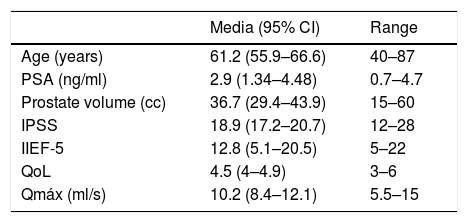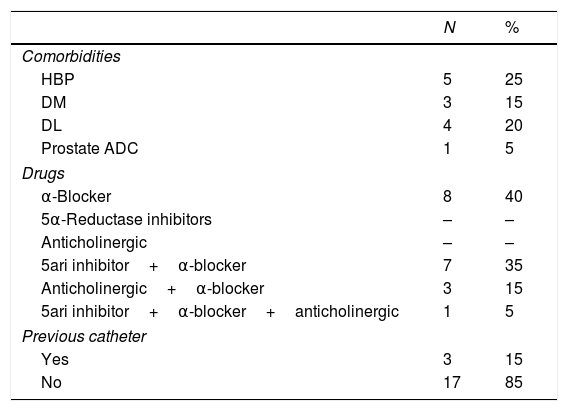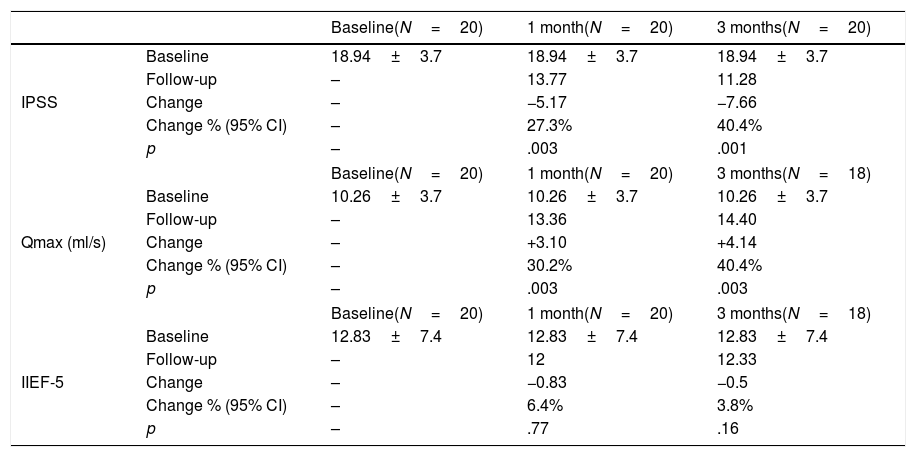The treatment for lower urinary tract symptoms secondary to benign prostatic hyperplasia with the Urolift® system has been carried out since 2005 with good results in the medium term. In this work, we present our experience performing this technique under local anaesthesia and sedation in 2 Spanish centres.
Material and methodsA prospective study was conducted with 20 patients treated with Urolift® under local anaesthesia and sedation between April 2017 and April 2018. The anaesthesia protocol consisted in the placement of 2 lubricants with cold lidocaine (the first one, 10min before the intervention, and the second one, just before introducing the cystoscopy). A prostate block (similar to the one employed in prostate biopsies) was administered to one third of the patients and 1mg of intravenous midazolam was added if required during the procedure. Our primary objective is to evaluate the tolerability of this procedure under local anaesthesia using the validated Visual Analogue Scale measurement instrument.
ResultsThe procedure has been performed under the same anaesthetic protocol to 20 patients from 2 different centres. The average pain scores on the Visual Analogue Scale were 1.37 for the cystoscopy procedure and 1.19 for the placement of the implants. When asked whether the pain sensations had been higher, lower or the same during the procedure or at the preoperative cystoscopy, only 18% of the patients responded it was higher. In all cases there was a good tolerance to the procedure, and changes to the anaesthesia protocols were never required.
ConclusionsWe consider that the Urolift® system under local anaesthesia and sedation is a well-tolerated, safe and effective method for the treatment of lower urinary tract symptoms secondary to benign prostatic hyperplasia.
El tratamiento de los síntomas del tracto urinario inferior secundarios a hiperplasia benigna de próstata con la utilización del sistema Urolift® se lleva realizando desde 2005 con buenos resultados a medio plazo. En este trabajo presentamos nuestra experiencia realizando esta técnica bajo anestesia local y sedación en 2 centros españoles.
Material y métodosSe llevó a cabo un estudio prospectivo con 20 pacientes tratados con Urolift® bajo anestesia local y sedación entre abril de 2017 y abril de 2018. El protocolo anestésico consistía en la colocación de 2 lubricantes con lidocaína fríos (el primero 10min antes de la intervención y el segundo momentos antes de iniciar la endoscopia). A un tercio de los pacientes se les añadió un bloqueo prostático similar al que se realiza en las biopsias de próstata y, según la tolerancia, durante el procedimiento, se les añadió 1mg de midazolam intravenoso. El objetivo primario es evaluar la tolerabilidad de este procedimiento bajo anestesia local usando la escala visual analógica.
ResultadosEl procedimiento ha sido realizado en 20 pacientes en 2 centros diferentes usando el mismo protocolo anestésico. La puntuación media en la escala escala visual analógica de dolor fue de 1,37 para la introducción del cistoscopio y de 1,19 para la colocación de los implantes. A la pregunta de si el dolor había sido mayor, menor o igual al de la cistoscopia diagnóstica, solo el 20% de los pacientes respondieron que había sido mayor. En todos los casos hubo una buena tolerancia al procedimiento, no precisándose en ninguno de ellos el cambio del tipo de anestesia.
ConclusionesConsideramos que la utilización del Urolift® bajo anestesia local y sedación es un método bien tolerado, seguro y eficaz para el tratamiento de los síntomas del tracto urinario inferior por hiperplasia benigna de próstata.












